Contents
Onions are one of the must-have crops for planting in the garden. Its shoots improve the taste of dishes, they contain vitamins and minerals. Among the frost-resistant and tasty varieties, April onion stands out. It is planted in summer cottages, at home they are distilled on a feather.
Features of the variety
The onion is a member of the onion family. The plant was brought from Asian countries, it is found in nature in China and Mongolia.
The aerial part of the culture resembles an ordinary onion. Shoots are long, densely arranged. Their taste is more refined and soft than that of onion varieties. Batun does not have a large bulb. Green feathers are eaten.
Aprelsky batun is an early ripening variety with high nutritional value. The culture is grown on a feather for fresh consumption. The plant produces green wide feathers, reaching 1 m. The shoots are juicy, tender, do not grow coarse for a long time, with a spicy aftertaste. Inflorescences are spherical, consist of many small flowers.
The period from the moment of planting to the first cut is 100 days. The April variety has an excellent taste, it is used for preparing salads, first and second courses.
Plant weight 200-300 g. Productivity per 1 square. m landings – 2 kg. Feather collection begins in early spring and ends in late autumn. During the season, the shoots are cut 3-4 times.
Advantages of the April variety:
- harvesting after the snow melts;
- increased content of vitamins and ascorbic acid;
- large and high-quality harvest;
- low susceptibility to disease;
- frost resistance;
- planting during spring, summer or before winter.
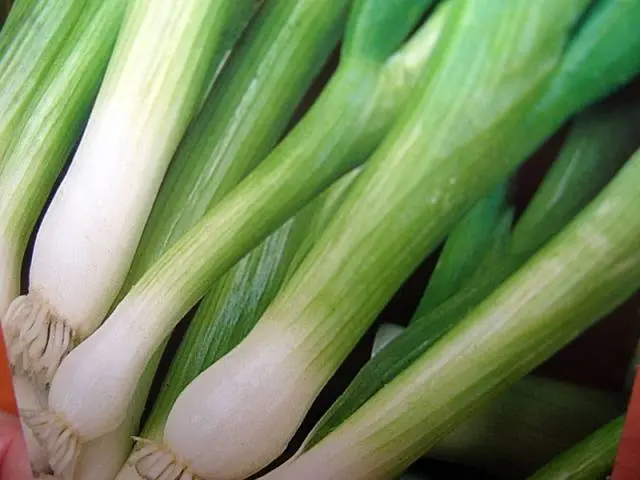
Onions are grown as an annual or perennial crop. Every year the culture grows and occupies more free space.
3-4 years after planting, the onion loses its useful properties. The plant produces a large number of arrows, which negatively affects the appearance and yield.
Growing in the garden
April onions are grown from seeds. Pre-prepare the soil and planting material. Plantings are looked after by watering, loosening the soil, and fertilizing.
Soil and seed preparation
Best of all, onion-batun grows on fertile sandy, chernozem or loamy soils. On peat and sandy soil, the plant is prone to the formation of a large number of arrows.
The culture does not tolerate moisture stagnation, which provokes rotting of the bulbs. Therefore, April onions are planted on drained soils that allow moisture and air to pass through well.
The predecessors for onions are potatoes, tomatoes, cabbage, peas, beans. After such plants, the soil contains fewer weeds. After garlic, cucumbers and carrots, planting is not performed.
The place for planting the culture is changed annually. The site should be fully illuminated by the sun, light partial shade is acceptable. Growing onion-batun April is permissible in wet places where there is no stagnant water.
In spring, the soil is loosened to a depth of 10 cm and fertilized with minerals. For 1 sq. m plantings take 20 g of urea, 30 g of potassium sulfide and 50 g of superphosphate. The components are buried in the soil.
Pre-treatment of seeds of the April variety helps to speed up the emergence of onion shoots. Before planting, the material is left for a day in warm water, which is changed every 6 hours. Additionally, the seeds are placed for an hour in a weak solution of potassium permanganate.
Another way to stimulate the germination of seeds of the April variety is bubbling. The seed material is kept in warm water with simultaneous air supply. The procedure accelerates the emergence of seedlings by a week and increases the yield of onions.
Landing onions
The April variety is planted at any time from late April to mid-August. When planting in autumn at the end of October, the crop is obtained after the snow melts.
The order of planting onion-batun April:
- Furrows are made on the bed, 20 cm are left between them. The number of rows depends on the width of the bed. It is most convenient to care for plants planted in 3 rows.
- Seeds are placed at a depth of 1-2 cm, maintaining a gap of 5 cm. Seed consumption when growing a perennial crop is 2 kg per 1 sq. m. Annual onions are planted more often and spend 3 g per 1 sq. m. m.
- Planting material is covered with earth and watered abundantly.
If there is a risk of spring frosts, then the planted onions are covered with agrofiber (spunbond, lutrasil). Shelter is especially important at night. Due to modern covering materials, it is possible to increase the temperature for planting by 5 ° C. Emerging shoots are thinned out, leaving a gap of 5-10 cm.
For the cultivation of Aprelsky batun in order to obtain an early harvest, planting is carried out in the fall. For the winter sowing of onions, the April plot is prepared in the summer. When it gets cold, when the temperature drops to +3 ° C, the seeds are planted in rows, between which they leave 20 cm. The soil is mulched with peat and covered with agrofiber. Thin out onions in spring.
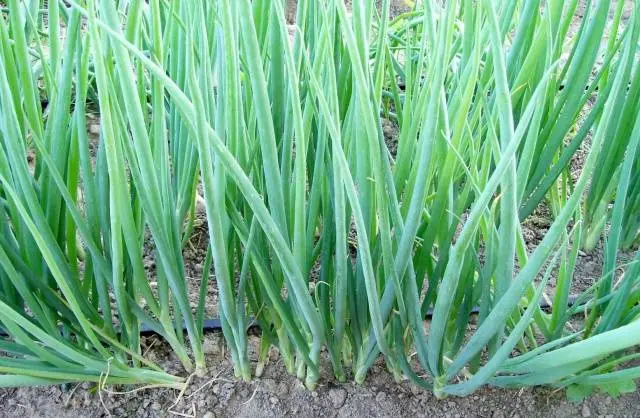
Care scheme
Onion-batun April needs regular care. The beds are watered taking into account weather conditions. In drought, water is applied every other day. After watering, the soil should be saturated with moisture 20 cm deep. For irrigation use warm settled water. The soil between the rows must be loosened.
A week after germination, the onions are watered with a solution of mullein in a ratio of 1:15. In the future, it is enough to dust the plantings with wood ash.
Landings attract onion fly, weevil, moth. Pests destroy the aerial parts of plants. When insects appear, April onions are sprayed with Fufanon or Karbofos preparations. After processing, wait a few days, and only then use onions for food.
Cultivation at home
April onions are successfully grown at home. Onions grow on the balcony from April to October, on the windowsill – throughout the year. Before planting, prepare the soil and process the seeds. Landings provide the necessary conditions: humidity, lighting, temperature.
Soil and seed preparation
When planting April onion-batuna in room conditions, fertile neutral soil is prepared. It is pre-steamed in a water bath or poured with a hot solution of potassium permanganate for disinfection.
Soil options for planting April onions:
- biohumus and coconut fiber;
- compost, peat and humus.
It is best to use fresh planting material collected 1-2 years ago. Before planting, April onion seeds are soaked for 12 hours in warm water. For disinfection for an hour, the seeds are kept in a weak solution of potassium permanganate.
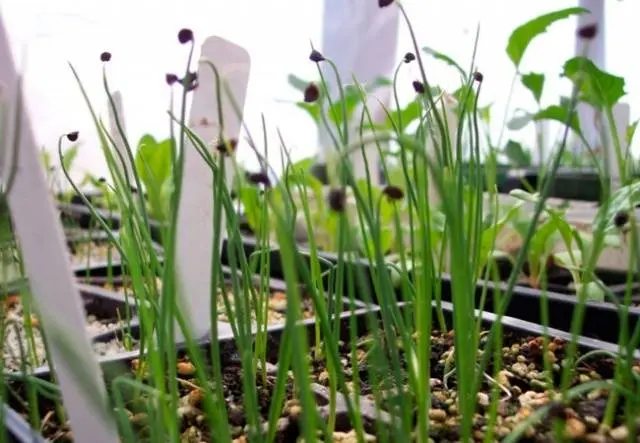
Landing onions
After preparing the seeds and soil, they start planting the April variety:
- A drainage layer is poured into the container in the form of pebbles, broken brick or expanded clay pieces.
- The substrate is laid on top.
- Furrows 2 cm deep are made on the surface of the soil.
- Seeds are placed in furrows, covered with soil and well watered.
- Landings are covered with a film to obtain a greenhouse effect.
- When shoots appear after 1-2 weeks, the containers are rearranged to a lighted place.
If the onion is already growing in the country, then it can be dug up in the fall and grown at home on the windowsill. Then fresh onion feathers are obtained in winter.
On the site, plants are selected at the age of 2-3 years. They are dug together with an earthen clod and transplanted into containers filled with nutrient soil. First, onions are stored at zero temperature for 1-2 months. A dormant period is essential for plants to get a good feather harvest.
Variety April at home is kept at a temperature of +18 to +20 ° C and a humidity of 80%. Greens are harvested after 3 weeks.
Care scheme
A high yield of Aprelsky onion-batun is obtained when grown on the southern, western and eastern windows. Landings provide a certain microclimate.
Seedlings are kept for 10 days in a cool place and partial shade to strengthen the onion root system. The place should be away from heaters and windows. Within a month, the growth process of the April onion variety is slow, but in the future, fresh greens can be obtained throughout the year.
April onion care includes:
- continuous lighting for 10 hours;
- moderate watering;
- airing the room;
- lack of drafts;
- constant feeding.
If necessary, install additional lighting. Fitolamps are fixed at a distance of 30 cm from the plants. They are turned on in the morning or in the evening so that the bow receives the necessary lighting.
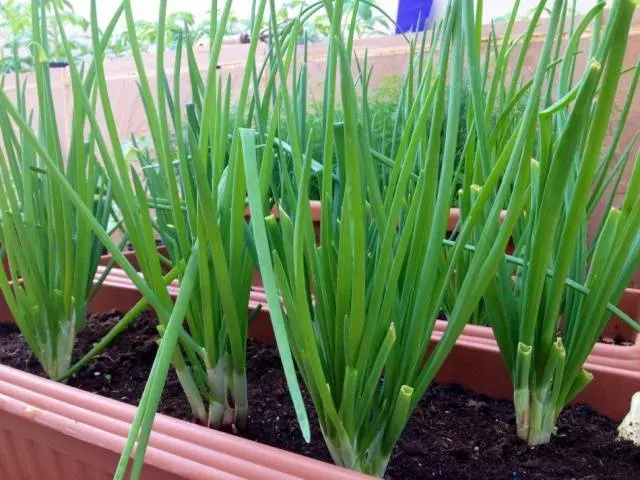
Plantings are regularly watered with warm settled water. Excessive soil moisture is detrimental to onions. Water is added when the soil begins to dry out.
Periodically, seedlings are fed with a solution consisting of 3 g of superphosphate and potassium salt per 1 liter of water. The agent is applied to the soil by irrigation. Between dressings observe a gap of 2-3 weeks.
Reviews of gardeners
Conclusion
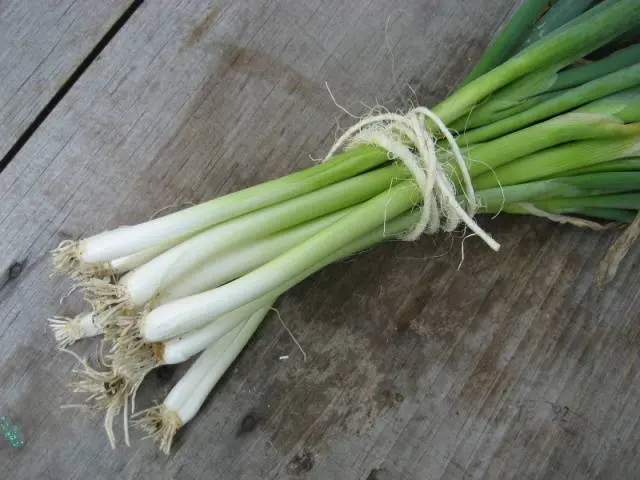
The April variety is valued for its frost resistance, excellent taste and high yield. The variety is adapted to any climatic conditions. The culture is grown as a perennial, then the plants are replaced every 3-4 years.
To care for onions, it is enough to water the plantings, loosen the soil and apply top dressing. Distillation at home allows you to collect fresh herbs in the autumn and winter. Plants provide good lighting, soil moisture, nutrients and access to fresh air.









